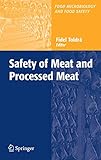Safety of Meat and Processed Meat / edited by Fidel Toldrá.
Tipo de material: TextoSeries Food Microbiology and Food SafetyEditor: New York, NY : Springer New York, 2009Descripción: recurso en líneaTipo de contenido:
TextoSeries Food Microbiology and Food SafetyEditor: New York, NY : Springer New York, 2009Descripción: recurso en líneaTipo de contenido: - texto
- computadora
- recurso en línea
- 9780387890265
- TP248.65.F66
Springer eBooks
Biological Hazards in Meat and Processed Meats -- Main Concerns of Pathogenic Microorganisms in Meat -- Fate of Escherichia coli O157:H7 in Meat -- Insights into Fresh Meat Spoilage -- Mycotoxins in Meat and Processed Meat Products -- Transmissible Spongiform Encephalopathy and Meat Safety -- Decontamination and/or Protection Technologies for Meat Processing -- Strategies for On-Line Decontamination of Carcasses -- Advanced Decontamination Technologies: High Hydrostatic Pressure on Meat Products -- Advanced Decontamination Technologies: Irradiation -- Control of Thermal Meat Processing -- Antimicrobials Treatment -- Biopreservation -- Oxidative Changes and Their Control in Meat and Meat Products -- Non-Biological Residues and Contaminants in Meat and Processed Meats -- Polycyclic Aromatic Hydrocarbons in Smoked Meats -- Veterinary Drugs and Growth Promoters Residues in Meat and Processed Meats -- Priority Environmental Chemical Contaminants in Meat -- Current Methodologies for the Detection of Contaminants in Meat and Processed Meats -- Real-Time PCR Methods for Detection of Foodborne Bacterial Pathogens in Meat and Meat Products -- Detecting and Tracking Emerging Pathogenic and Spoilage Bacteria from Farm to Fork -- Molecular Analysis of Pathogenic Bacteria and Their Toxins -- Methodologies for the Detection of BSE Risk Material in Meat and Meat Products -- GMO Detection -- Risk Assessment and Regulations on Meat Safety -- Principles of Predictive Modeling -- Predictive Modeling of Pathogen Growth in Cooked Meats -- Microbiological Quantitative Risk Assessment -- Quantitative Risk Assessment of Bovine Spongiform Encephalopathy -- Regulations on Meat Hygiene and Safety in the European Union -- Regulations on Meat Hygiene in the USA.
Safety of Meat and Processed Meat provides the reader with the recent developments on safety, from the abattoir along the processing chain to the final product. To achieve this goal, the editor uses five approaches. The first part deals with the main biological contaminants like pathogen microorganisms, toxins, meat spoilage and BSE material that can be present either in meat or its derived products. The second part focuses on main technologies for meat decontamination like high pressure or bioprotective cultures to extend the shelf life. The third part presents non-biological contaminants and residues in meat and meat products including PAH, veterinary drugs and environmental compounds. The fourth part discusses current methodologies for the detection of spoilage and pathogen microorganisms, its toxins, BSE material and GMOs, and the final part deals with predictive models, risk assessment, regulations on meat safety and other recent trends in the field. This book is written by distinguished international contributors from 18 countries with excellent experience and reputation. In addition, brings together advances in different safety approaches. Fidel Toldrá is a Professor at the Instituto de Agroquímica y Tecnología de Alimentos (CSIC) in Valencia, Spain.
Para consulta fuera de la UANL se requiere clave de acceso remoto.


